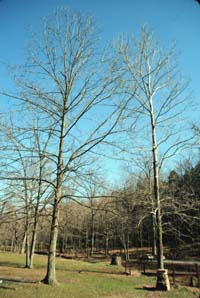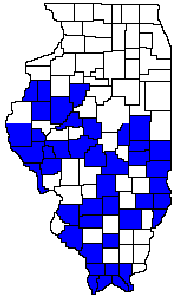 |
| Kingnut
Hickory (Carya laciniosa)
Distribution
Map to Right |

Kingnut or shellbark hickory is a large tree growing to heights of 100 feet with trunk diameter of 3 to 4 feet. The trunk is usually straight and has drooping lower branches. The tree is slow growing and reproduces from seed and stump sprouting, living to be 100 - 200 years old.
Interesting
Facts
The hickories
are divided into three groups comprised of the pecans, the shagbarks, and
the pignuts. Kingnut (also called shellbark) hickory is in the shagbark
group, which is distinguished from the others by large terminal buds, bark
that peels off in long, sometimes curling strips, and thick twigs. Kingnut
hickory is further distinguished from other hickories by its orange-brown
dotted twigs which may be slightly hairy.
Identifying Features
Bark
Kingnut hickory bark is light gray and smooth when the tree is young, breaking into long, shaggy, curling strips when the trunk is 4 – 8 inches in diameter.
Leaves
The leaves are alternate, pinnately compound, with 5 - 9 lance-shaped leaflets. The leaflets, which are pointed at the tip and finely toothed at the edges, are up to 10 inches long and half as wide. The entire leaf is quite large - up to 24 inches long. Leaflets are dark green and smooth on the upper surface and paler and slightly hairy below.
Flowers
Male and female flowers are born separately on the same tree (moneocious), the males as drooping catkins, both of which appear after the leaves have begun to unfold in the spring.
Fruits
The nuts are up to 2 1/2 inches in diameter, more or less round, with the husk divided all the way to the base in four sections. They are light brown and have very tiny, orange speckles. They ripen in August - October and have very sweet seeds that are sold commercially for human consumption.
Uses
Kingnut
hickory nuts are edible and sold commercially. Squirrels also eat the nuts.
The wood is hard, very strong, and close grained. It is used for tool handles,
agricultural implements, interior finishing, and for fuel. Native Americans
used kingnut hickory medicinally for pain.